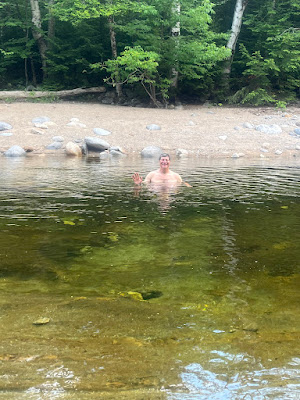June 14 - July 1, 2024: Dolly Copp Campground in the White Mountain
After leaving central FL in March we spent about a month visiting family in the Richmind VA area. We then headed to our son's Christmas tree farm in NH for a couple of months where we helped plant 1400 seedlings and other farm work. With the prediction of an early season heat in mid-June we ended up at Dolly Copp Campground to avoid the brunt of the wave. Here is how we ended up at Dolly Copp.
I believe the Dolly Copp Campground is the closest campground to the Appalachian Mountain Club's (AMC) Pinkham Notch Visitor Center. My bike ride from the campground to the visitor's center was 7 miles one way. The Pinkham Notch Visitor Center is an AMC "hut" that is well known in NH since it sits at the base of Mount Washington, the highest mountain in the northeastern US (6288'). We headed to this campground knowing there was a heat wave predicted during the later part of the week of June 16. We considered going to Acadia National park in Maine to escape the heat but we waited until it was too late and availability there was almost non-existent. As our back up plan, we wanted electric hook ups so we could run the air conditioning without electricity supply constraints. I believe Dolly Copp is the only White Mountain National Forest Campground (WMNF) that has electricity hook ups (available at some sites) and that is only after the campground was significantly rehabilitated during 2017-2021. We weren't able to make reservations due to our last minute planning, but the campground has a number of first come, first serve sites so we assumed we would find a site with hook ups with our non-week end arrival. We found several. We started out at site 13 but moved to site 17 after our first night. I wasn't in any hurry to connect the utilities on our first night. When I tried to connect the next morning, I found the threaded connection of the water faucet was missing a hunk and therefore a seal with the hose was not possible. We went to the campground office to complete registration and explore options. We decided on moving to site 17 which was available and had a wider view to the sky. The view was a consideration since our Starlink was encountering multiple obstructions, aka trees, at site 13. Site 17 still had the issue but was much reduced. Here is the camper at Site 17. You can see the Starlink terminal to the left of the picnic table.
We signed up for one week before deciding on staying the maximum allowed of 14 consecutive days. Jane used that time well working on a quilt for our newest grandson. The sewing machine doesn't use much power but her iron does when it cycles on so having electricity was a nice perk.
As I mentioned I biked, from the campground to the visitor's center. It was a 16 mile round trip since I went a little past the center. It would take me about an hour up the mountain and a third of an hour down the mountain. The steepest part of the ascent was a slog for me (8% grade at its steepest). The ride afforded me multiple views of Mt. Washington from the valley. I passed a placard about the first ascent of Mt. Washington by a non-native American. You can see the entrance to the center's parking lot in the first picture.
I was able to find two nearby swimming holes in the Peabody River after doing some internet research. We had camped at Dolly Copp 25-30 years ago and I remember swimming there back then. The office staff wasn't much help other than confirming they knew some people that found a location. The first swimming hole I found was the one I had the best information about. To get there we biked to the end of the campground (it is a large campground with almost 200 sites and the swimming hole is along a trail at the far end from where we camped) and then walked & biked about a half a mile along the trail; walking when the trail was too rocky. I swam at this first swimming hole on two of the hotter days. I believe the name of this one is the Ranger Pool as I saw a couple of iron pins in the shore bedrock ( see "An iron pin from the logging era is anchored in bedrock on the west edge of the pool", page 82 of https://www.dollycopp.com/dollycopp.pdf). Here are some pictures.
I found the Flat Rock Pool (page 81, ibid) after multiple searches and, since it right next to Route 16, bike ride observations. There are two paths from the campground to the pool that connect there. One path starts near site 18 and the other, near the Hayes Field bathroom. I swam in the pool one day during the second week of our stay. Other visitors arrived from the Route 16 side. Here are some pictures.
At the end of the campground where the trail to the Rangers Pool was located was a Recreation Hall, which appeared to be in good shape but unused, and an unusual log sculpture (see page 79, ibid). The sculpture was a log spiral as can be seen below.

















Comments
Post a Comment